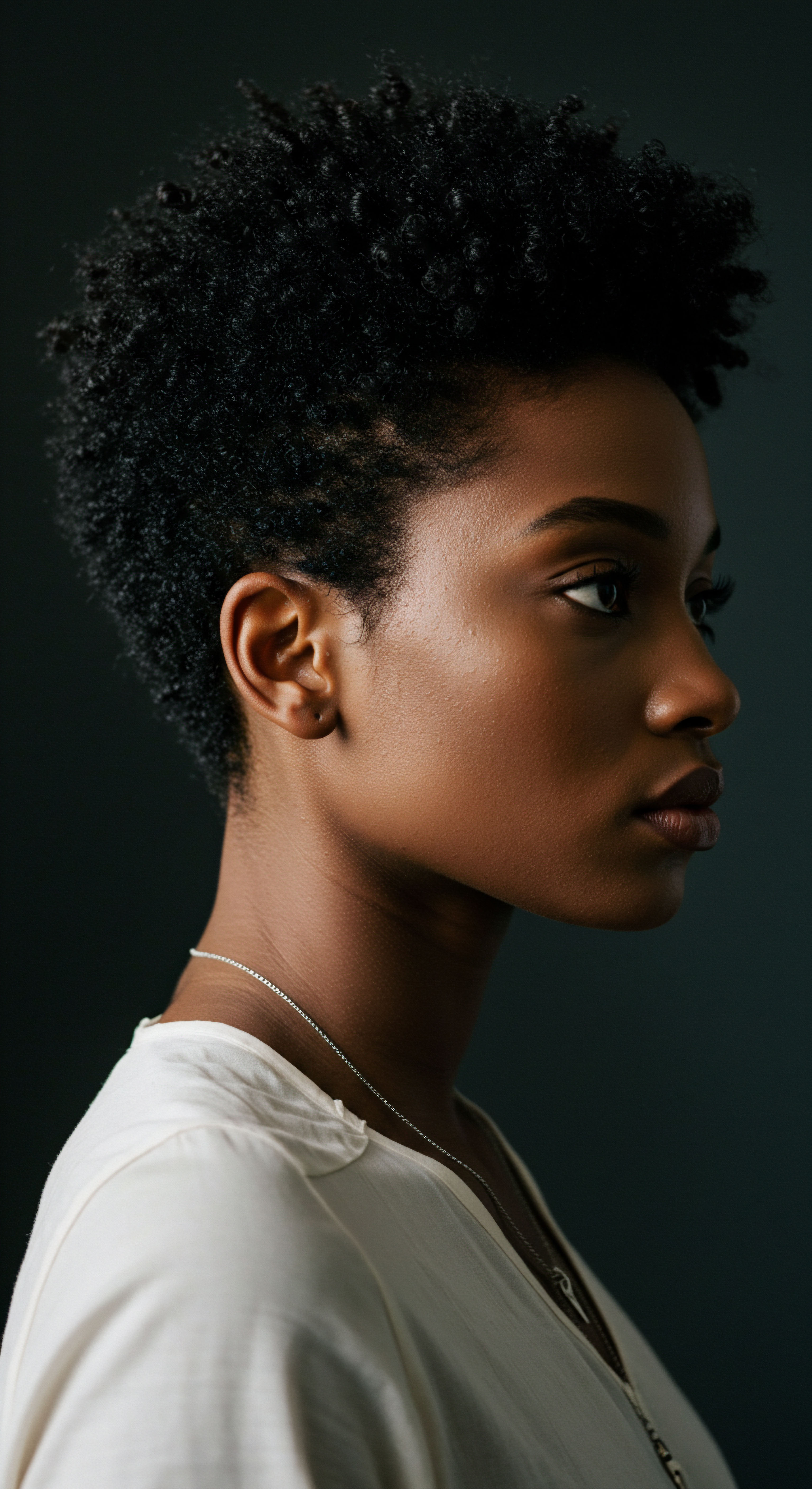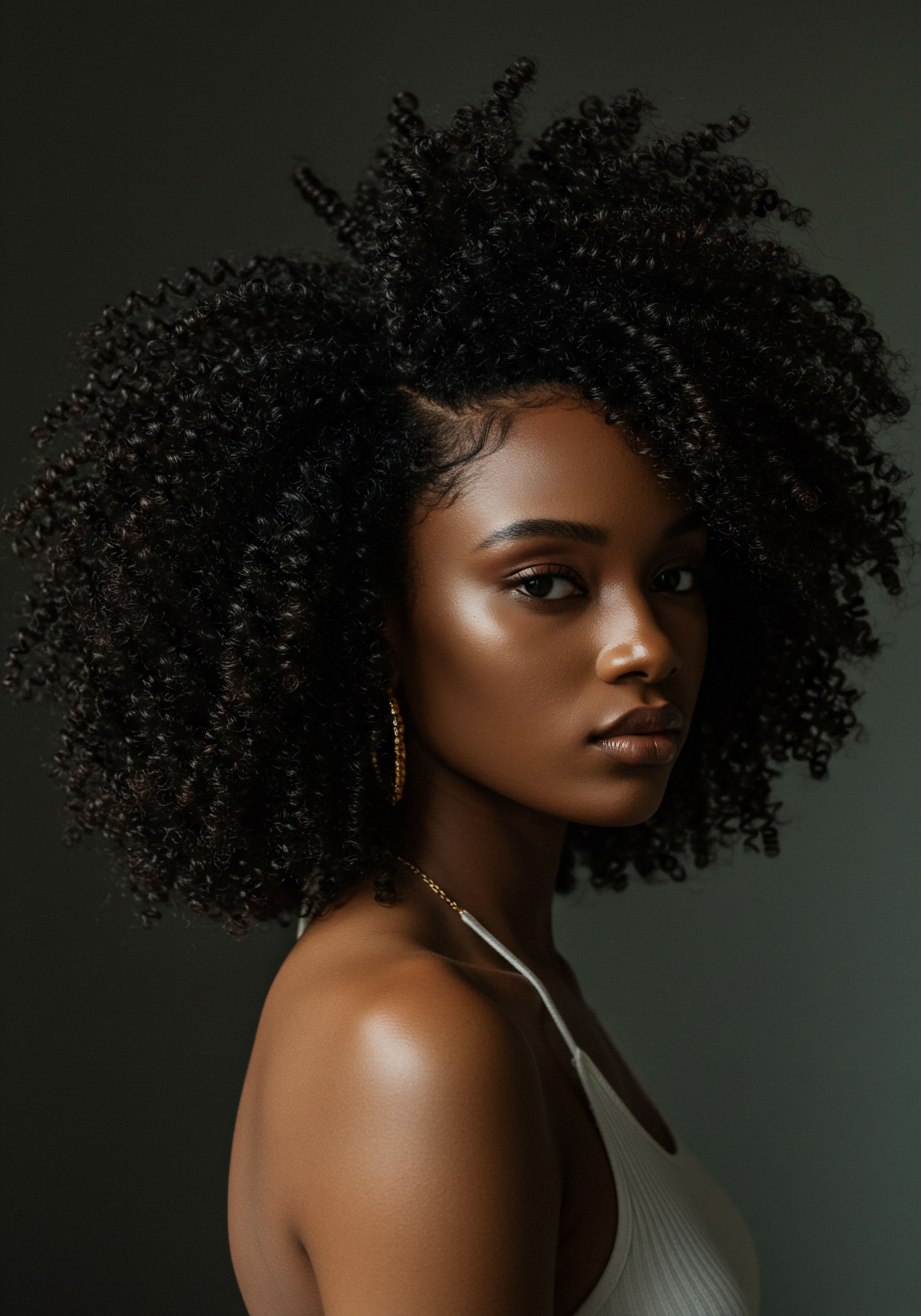
Roots
The quiet rhythm of night, a time when the world stills and the body begins its profound work of restoration, holds a delicate connection to the vitality of our hair. Many of us perceive sleep as merely a pause from the day’s demands, a necessary reprieve for weary minds and muscles. Yet, beneath the surface of slumber, an intricate ballet of cellular repair and hormonal recalibration unfolds, directly influencing the very strands that crown our heads.
To truly understand the role of sleep quality in hair growth, we must journey to the biological heart of the matter, exploring the foundational processes that occur when we surrender to the night. It is in these hidden moments of rest that the groundwork for healthy, vibrant hair is laid, a testament to the body’s remarkable capacity for self-renewal.

The Hair Follicle’s Nocturnal Rhythm
Our hair does not grow continuously throughout the day; instead, each strand adheres to a cyclical pattern, a sophisticated biological clock that orchestrates its phases. This rhythm, much like our own sleep-wake cycle, is deeply influenced by internal signals and external cues. The hair growth cycle consists of three primary phases:
- Anagen ❉ This is the active growth phase, where hair follicles produce new hair cells rapidly. It can last for several years, determining the length of our hair.
- Catagen ❉ A brief transitional phase where hair growth slows, and the follicle begins to shrink. This stage lasts only a few weeks.
- Telogen ❉ The resting phase, during which hair stops growing and eventually sheds to make way for new growth. This phase typically lasts a few months.
During periods of deep sleep, particularly the non-REM stages, the body shifts into a dedicated mode of repair and growth. This is a crucial window when cellular turnover increases, tissue repair accelerates, and the levels of vital hormones, such as melatonin and growth hormone, rise significantly. These factors collectively support the anagen phase of the hair cycle, promoting robust and consistent growth. Conversely, sleep that is fragmented or insufficient can shorten this active growth phase, potentially leading to slower growth or an increase in shedding over time.

Hormonal Orchestration During Sleep
Sleep acts as a conductor for the body’s hormonal orchestra, ensuring that key players are in harmony to support overall well-being, including hair health. Two hormones in particular stand out for their direct influence:
- Melatonin ❉ Widely recognized for its role in regulating our sleep-wake cycles, melatonin also appears to stimulate hair growth. Research indicates that hair follicles possess melatonin receptors, suggesting a direct involvement of this hormone in the hair growth cycle. Topical applications of melatonin have even been studied for their potential to prolong the anagen phase and enhance hair density.
- Growth Hormone ❉ This hormone is released primarily during deep sleep and is essential for cell regeneration and tissue repair throughout the body, including the hair follicles. Adequate levels of growth hormone contribute to the repair and vitality of hair cells, laying the groundwork for healthy strands.
When sleep is consistently disturbed, the delicate balance of these hormones can be upset. A reduction in melatonin and growth hormone can weaken hair follicles and slow down the rate of new hair formation. This intricate hormonal interplay underscores why a peaceful night’s rest is not merely a luxury, but a biological imperative for the continuous vitality of our hair.
The quiet moments of sleep are when our hair’s foundational growth and repair processes truly take hold.
Beyond the direct hormonal impact, the body’s overall systemic health, heavily influenced by sleep, plays a profound part. Proper circulation, for instance, ensures that the scalp receives the necessary oxygen and nutrients for hair follicles to thrive. When sleep is compromised, so too can be this vital blood flow, depriving follicles of the sustenance they require. This foundational understanding sets the stage for appreciating how disruptions to our nocturnal routine can ripple through our physiology, eventually manifesting in the appearance and resilience of our hair.

Ritual
Moving beyond the quiet, unseen mechanisms of the body, we arrive at the tangible rhythms of our daily lives, where practical wisdom meets the desire for flourishing hair. The way we honor our nights, the deliberate choices we make as daylight fades, can shape the very health of our strands. It is a shared understanding that what we do before we close our eyes carries weight, and this is particularly true for our hair.
This section delves into the actionable aspects, exploring how the quality of our rest, and the rituals surrounding it, translate into the visible condition of our hair. We will uncover how common disturbances reverberate through our hair’s vitality, and how gentle adjustments can become powerful acts of care.

The Shadow of Sleep Deprivation on Hair
When sleep becomes a scarce commodity, the body often reacts with a cascade of responses designed for survival, not for luxuriant hair. One of the most immediate and impactful consequences is the elevation of Cortisol, the body’s primary stress hormone. Chronic high levels of cortisol are linked to various forms of hair loss, including:
- Telogen Effluvium ❉ This condition involves increased shedding, as stress hormones prematurely push hair follicles into the resting (telogen) phase.
- Androgenetic Alopecia ❉ While often genetically predisposed, the progression of this common hair thinning can be worsened by persistent stress.
- Alopecia Areata ❉ An autoimmune condition where the immune system mistakenly attacks hair follicles. Poor sleep quality can negatively affect the immune system, potentially triggering or exacerbating autoimmune responses in individuals with a genetic predisposition.
A sustained state of elevated cortisol creates an environment hostile to optimal hair growth. It can shorten the active growth phase, leading to thinner, weaker hair over time. The body, under perceived threat, reallocates resources away from “non-essential” functions like hair production, prioritizing immediate survival.

Circulation and Nutrient Delivery
The health of our hair is inextricably linked to the nourishment it receives from the bloodstream. During restful sleep, blood flow to the scalp increases, delivering a steady supply of oxygen and essential nutrients to the hair follicles. This robust circulation is vital for supporting cellular activity and the energetic demands of hair growth.
When sleep is compromised, so too can be this critical delivery system. Restricted blood flow due to poor sleep can hinder the nourishment of follicles, potentially resulting in weaker strands and slower growth. Imagine a garden receiving insufficient water and nutrients; its plants would struggle to flourish. Our hair follicles are no different, requiring a consistent and ample supply of resources to maintain their vitality.
Disrupted sleep can manifest as increased hair shedding, a visible echo of the body’s internal stress response.

Does Sleep Quality Influence Hair Texture?
While the direct scientific evidence specifically linking sleep quality to changes in textured hair patterns remains an area ripe for deeper exploration, the broader impacts on hair health suggest an indirect influence. The processes affected by sleep—hormonal balance, nutrient delivery, and stress levels—all contribute to the overall strength, elasticity, and integrity of the hair shaft. For textured hair, which often possesses unique structural characteristics and moisture needs, any compromise to these foundational elements can have noticeable effects.
For instance, if inadequate sleep leads to increased shedding or a shortening of the anagen phase, the result could be a perceived reduction in density or length retention. Furthermore, chronic stress, a common companion to sleep deprivation, can lead to practices that may inadvertently harm textured strands, such as increased manipulation or a tendency to neglect careful nighttime rituals due to fatigue. While a direct causal link to texture alteration is not firmly established, a well-rested body creates the most favorable environment for all hair types to express their inherent beauty and resilience.
| Sleep Disruption Aspect Elevated Cortisol |
| Hair Health Marker Affected Hair Growth Cycle |
| Observed Effect Premature entry into telogen phase, increased shedding |
| Sleep Disruption Aspect Reduced Blood Flow |
| Hair Health Marker Affected Nutrient Delivery to Follicles |
| Observed Effect Weakened hair, slower growth |
| Sleep Disruption Aspect Hormonal Imbalance |
| Hair Health Marker Affected Melatonin and Growth Hormone Levels |
| Observed Effect Weakened follicles, slowed regrowth |
| Sleep Disruption Aspect Weakened Immune System |
| Hair Health Marker Affected Scalp Health, Autoimmune Triggers |
| Observed Effect Increased susceptibility to infections, potential alopecia areata flare-ups |
| Sleep Disruption Aspect Consistent, quality sleep is essential for mitigating these negative impacts and supporting vibrant hair. |

Relay
As we move from the intimate landscape of daily habits to the broader, interconnected systems of the body, a deeper question emerges ❉ How does the subtle, persistent disruption of our internal clock, the very rhythm that governs life, reverberate through the seemingly distinct domain of hair growth? Here, we venture into the more sophisticated understanding, drawing connections between the nuanced science of chronobiology and the profound impact it holds for our strands. This is where research unveils the less obvious yet potent influences, inviting us to consider hair health not as an isolated concern, but as a sensitive barometer of our systemic equilibrium.

The Circadian Clock and Hair Follicle Stem Cells
Beyond the direct effects of hormones and stress, a more intricate relationship exists between our sleep patterns and the fundamental cellular machinery of hair growth ❉ the circadian clock within the hair follicles themselves. Hair follicles possess their own localized biological clocks, which regulate the proliferation and activity of hair follicle stem cells (HFSCs). These stem cells are the unsung heroes of hair regeneration, responsible for initiating new growth cycles.
Research indicates that the expression of core clock genes, such as BMAL1 and PER1, within hair follicles is not only present but also fluctuates in a hair cycle-dependent manner. This suggests that the circadian system actively modulates the hair follicle cycle. A compelling illustration of this intricate relationship comes from studies on circadian rhythm disruptions. For example, a 2019 study published in Cell Reports revealed that Circadian Rhythm Disruptions, Such as Those Experienced by Shift Workers, Were Linked to Decreased Stem Cell Activity in the Hair Follicles of Mice.
This chronic disruption can diminish the regenerative capacity of these cells over time, potentially resulting in thinner, weaker hair. This particular finding highlights a less commonly discussed, yet biologically significant, pathway through which our sleep-wake patterns can directly influence the long-term vitality of our hair.

The Immune System Connection
The link between sleep and hair health extends to the immune system, a complex network that safeguards our body. Sleep deprivation is widely recognized for its detrimental effects on immune function, weakening the body’s defenses. This compromised immunity can have direct implications for scalp health and, by extension, hair growth.
An immune system under duress can lead to inflammation, which is known to affect hair follicles adversely. Inflammatory responses around hair follicles can hinder their proper function, making it harder for them to produce new, healthy hair. Furthermore, certain autoimmune conditions that cause hair loss, such as alopecia areata, have shown associations with sleep disturbances.
A 2022 study found a significant connection between severe alopecia areata and sleep issues, including insufficient sleep and high stress levels. This suggests a bidirectional relationship, where poor sleep may act as a trigger for autoimmune flare-ups, and the psychological distress of hair loss can, in turn, disrupt sleep quality.
The hair follicle, with its own internal timekeeping, directly responds to the subtle shifts of our sleep-wake cycle.

Beyond the Obvious ❉ Metabolic Crosstalk and Hair
The conversation surrounding sleep and hair often centers on stress hormones or direct nutrient supply, yet the deeper scientific discourse points to an intricate metabolic crosstalk. The circadian clock influences glucose metabolism, cellular differentiation, and even senescence – the aging process of cells. These broader metabolic shifts, when disturbed by inconsistent sleep, can have downstream effects on hair follicle regeneration.
For instance, the levels of reactive oxygen species (ROS) in tissues are closely connected to hair follicle regeneration. Loss of a functional circadian clock in stem cells can lead to a significant increase in ROS production, potentially increasing inflammatory damage within the hair follicle environment. This suggests that the delicate balance of cellular energy and waste management, heavily influenced by our sleep rhythms, directly impacts the health and regenerative capabilities of our hair. The metabolic health of the body, meticulously regulated by sleep, provides the optimal internal landscape for hair to flourish.
Understanding this deeper layer of interaction, where the microscopic cellular clock synchronizes with our macroscopic sleep patterns, allows for a more comprehensive approach to hair wellness. It underscores that true hair vitality is not simply a matter of external application or genetic lottery, but a reflection of a body working in harmonious rhythm, a rhythm nurtured by profound rest.
| Phase Anagen |
| Description Active growth, cell division, new hair shaft formation. |
| Key Influencing Factors Growth hormone, melatonin, nutrient availability, robust blood flow, balanced circadian rhythms. |
| Phase Catagen |
| Description Transitional phase, growth slows, follicle shrinks. |
| Key Influencing Factors Stress hormones (cortisol), inflammatory signals. |
| Phase Telogen |
| Description Resting phase, hair sheds, new growth prepares. |
| Key Influencing Factors Elevated cortisol, sleep deprivation, immune system dysregulation, chronic stress. |
| Phase Exogen |
| Description Shedding of old hair, part of telogen or distinct. |
| Key Influencing Factors Natural cycle progression, external stressors. |
| Phase Optimizing sleep quality can positively impact each phase, supporting a healthy hair growth cycle. |

Reflection
The journey through the intricate connection between sleep quality and hair growth reveals a profound truth ❉ our hair, in its myriad textures and forms, is not merely an adornment but a living testament to our inner harmony. The quiet hours of night, often overlooked in our fast-paced world, emerge as a sanctuary for cellular renewal and hormonal balance, orchestrating a symphony of biological processes that underpin vibrant strands. From the microscopic dance of hair follicle stem cells governed by their own internal clocks to the sweeping influence of stress hormones and systemic inflammation, the narrative of hair health is deeply intertwined with the story of our rest.
To nurture our hair, then, is to nurture ourselves, to listen to the whispers of our body’s natural rhythms, and to honor the restorative power of deep, undisturbed sleep. It is an invitation to pause, to breathe, and to create space for the profound healing that only true rest can provide. In this gentle surrender, we do not simply improve our hair; we reclaim a piece of our inherent well-being, allowing our authentic radiance to shine through, from the roots of our being to the very ends of our hair.

References
- 1. Fischer, T. W. Elsner, P. & Maibach, H. I. (2009). Hair and Scalp Diseases ❉ Medical, Surgical, and Cosmetic Treatments. CRC Press.
- 2. Bolduc, C. & Shapiro, J. (2019). Hair Loss ❉ Medical and Surgical Management. CRC Press.
- 3. Blume-Peytavi, U. & Tosti, A. (2018). Hair Growth and Disorders. Springer.
- 4. Trueb, R. M. (2016). Hair Loss in Women ❉ Medical and Cosmetic Approaches. Springer.
- 5. Cotsarelis, G. & Botchkarev, V. (2012). Chapter 86. Biology of Hair Follicles. In L. A. Goldsmith, S. I. Katz, B. A. Gilchrest, A. S. Paller, D. J. Leffell, & K. Wolff (Eds.), Fitzpatrick’s Dermatology in General Medicine (8th ed.). McGraw-Hill Education.
- 6. Montagna, W. (1958). The Biology of Hair Growth. Academic Press.
- 7. Hsiao, Y. H. Chen, Y. T. Tseng, C. M. Wu, L. A. Lin, W. C. Su, V. Y. F. & Lee, Y. C. (2015). Sleep disorders and increased risk of autoimmune diseases in individuals without sleep apnea. Sleep, 38 (4), 581-586.
- 8. Seo, H. M. Kim, T. L. & Kim, J. S. (2018). The risk of alopecia areata and other related autoimmune diseases in patients with sleep disorders ❉ a Korean population–based retrospective cohort study. Sleep, 41 (9), zsy111.
- 9. Fischer, T. W. Burmeister, G. Schmidt, N. & Elsner, P. (2004). Melatonin increases anagen hair rate in women with androgenetic alopecia or diffuse alopecia ❉ results of a pilot study. International Journal of Dermatology, 43 (8), 614-617.
- 10. Fischer, T. W. Slominski, A. Tobin, D. J. Paus, R. & Elsner, P. (2008). Melatonin and the hair follicle. Journal of Pineal Research, 44 (1), 1-15.
- 11. Siahkouhian, M. & Behnaz, M. (2020). The Quality of Sleep and Quality of Life in Patients with Alopecia. Journal of Sleep Sciences, 5 (2), 99-103.
- 12. Ghafarpour, G. Zamanian, A. Rasi, A. Asadbeigi, S. & Ghods, S. (2017). The Prevalence of Sleep Disorders in Patients with Alopecia Areata. Journal of Dermatology and Cosmetic, 8 (2), 98-103.
- 13. Lin, Y. S. et al. (2019). Local circadian clock gates cell cycle progression of transient amplifying cells during regenerative hair cycling. Proceedings of the National Academy of Sciences, 116 (40), 19965-19974.
- 14. Janich, P. et al. (2019). Follicular bulge stem cells display inherent circadian heterogeneity to physiological activation. Cell Reports, 27 (10), 2955-2968.e5.
- 15. Uslu, H. et al. (2014). Melatonin treatment inhibits hair follicle keratinocyte apoptosis and downregulates estrogen receptor-α expression in murine model. Dermatologic Therapy, 27 (3), 164-169.